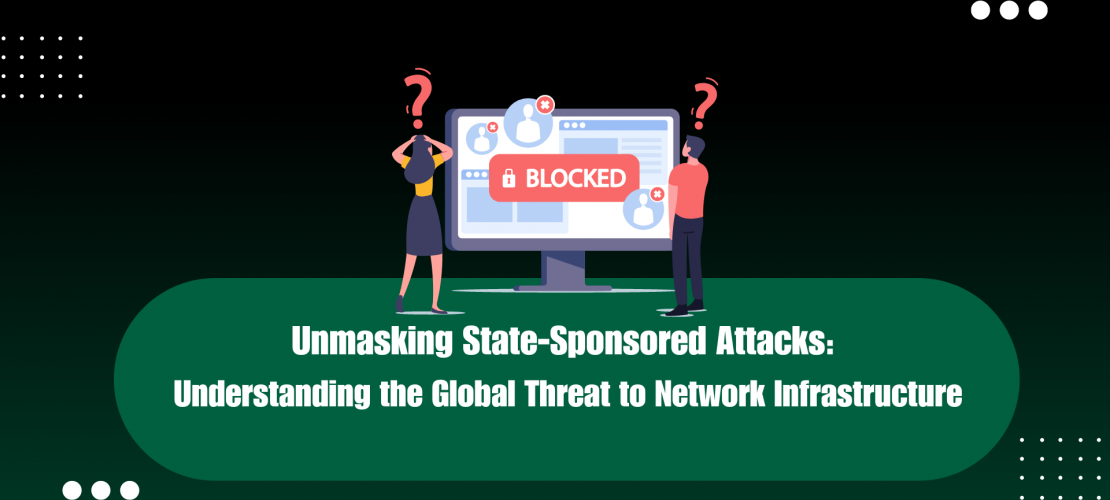In the ever-evolving landscape of cybersecurity, one of the most concerning and sophisticated threats is state-sponsored attacks. These attacks are not carried out by individual hackers or criminal organizations, but rather by nation-states with the intention of gaining unauthorized access, stealing sensitive information, disrupting critical infrastructure, or furthering geopolitical agendas. In this blog, we will delve into the world of state-sponsored attacks, understand their motivations and tactics, and explore the global threat they pose to network infrastructure.
Understanding State-Sponsored Attacks
State-sponsored attacks, also known as advanced persistent threats (APTs), involve sophisticated and well-funded adversaries, often backed by nation-states. These attackers possess significant resources, including advanced technologies, intelligence capabilities, and a deep understanding of cybersecurity vulnerabilities. State-sponsored attacks are typically long-term and highly targeted, aiming to gain persistent access to a target’s network infrastructure.
Motivations and Objectives
State-sponsored attacks are driven by various motivations and objectives:
- Espionage: Nation-states conduct cyber espionage to gain access to sensitive information, such as military secrets, intellectual property, trade secrets, or political intelligence. This information can be used to gain a competitive advantage or influence global affairs.
- Disruption and Sabotage: Some state-sponsored attacks aim to disrupt critical infrastructure, including energy grids, transportation systems, financial institutions, or government networks. By causing chaos and disruption, attackers can destabilize economies or compromise national security.
- Political Influence: State-sponsored attackers may target political parties, government agencies, or election systems to influence elections, manipulate public opinion, or gather intelligence for geopolitical purposes.
- Economic Warfare: Nation-states engage in economic warfare by targeting businesses and industries to gain economic advantage or weaken competing nations. This can involve stealing trade secrets, intellectual property, or conducting economic espionage.
Tactics and Techniques
State-sponsored attacks employ advanced tactics and techniques to evade detection and gain persistent access to target networks. Some common techniques include:
- Advanced Malware: Attackers develop sophisticated malware, including custom-built tools, to bypass traditional security measures and remain undetected within a target’s network. This can include remote access Trojans (RATs), keyloggers, or advanced persistent malware.
- Social Engineering: State-sponsored attackers often employ social engineering techniques to trick individuals within the target organization into divulging sensitive information or clicking on malicious links. This can include phishing emails, spear phishing, or impersonation tactics.
- Zero-day Exploits: Attackers exploit unknown vulnerabilities in software or hardware, known as zero-day exploits, to gain unauthorized access to target systems. These vulnerabilities are not yet patched or known to the vendor, making them powerful tools for attackers.
- Supply Chain Attacks: State-sponsored attackers may compromise the software or hardware supply chain to inject malicious code or backdoors into widely used products. This allows them to gain access to target systems indirectly through trusted sources.
The Global Threat to Network Infrastructure
State-sponsored attacks pose a significant threat to network infrastructure worldwide. As nation-states continue to invest in cyber warfare capabilities, the scale and sophistication of these attacks increase. The consequences of successful state-sponsored attacks can be severe:
- National Security Implications: State-sponsored attacks targeting critical infrastructure, military networks, or government systems can compromise national security, disrupt operations, and compromise sensitive information.
- Economic Impact: The theft of intellectual property, trade secrets, or economic espionage can have severe economic consequences for targeted countries and industries. It can lead to financial losses, reduced competitiveness, and economic instability.
- Geopolitical Unrest: State-sponsored attacks can escalate tensions between nations, leading to geopolitical unrest and strained international relations. Cyber espionage and influence campaigns can undermine trust and cooperation among countries.
- Public Trust and Privacy: Successful state-sponsored attacks can erode public trust in digital systems and compromise individuals’ privacy. Citizens may become skeptical about the security and privacy of their personal information, leading to concerns about surveillance and data breaches.
Mitigating State-Sponsored Attacks
Mitigating state-sponsored attacks requires a multi-layered approach to security:
- Robust Cybersecurity Measures: Implement strong cybersecurity measures, including firewalls, intrusion detection systems, and anti-malware solutions. Regularly update and patch software to address vulnerabilities and ensure all security controls are in place.
- Network Segmentation: Segment your network infrastructure to isolate critical systems and limit lateral movement within the network. This prevents attackers from gaining widespread access in the event of a breach.
- Employee Education and Training: Conduct regular cybersecurity awareness training for employees to educate them about the risks of state-sponsored attacks, social engineering tactics, and best practices for maintaining security.
- Threat Intelligence and Monitoring: Deploy advanced threat intelligence tools and solutions to monitor network traffic, detect suspicious activities, and identify potential state-sponsored attacks in real-time. This includes leveraging threat intelligence feeds, security analytics, and behavior-based monitoring.
- Incident Response Planning: Develop an effective incident response plan that outlines the steps to be taken in the event of a state-sponsored attack. This includes incident identification, containment, eradication, and recovery procedures.
- Collaboration and Information Sharing: Foster collaboration with government agencies, industry partners, and security communities to share threat intelligence, best practices, and insights on state-sponsored attacks. This collective effort can strengthen defenses and enhance the overall cybersecurity posture.
Conclusion
State-sponsored attacks represent a significant and evolving threat to network infrastructure globally. As nation-states continue to invest in cyber warfare capabilities, organizations and governments must remain vigilant and take proactive measures to protect their networks and critical systems. By understanding the motivations, tactics, and techniques of state-sponsored attackers, implementing robust cybersecurity measures, and fostering collaboration, we can collectively defend against these sophisticated threats. Protecting our network infrastructure is not just a matter of security; it is crucial for safeguarding national security, economic stability, and public trust in the digital realm.




